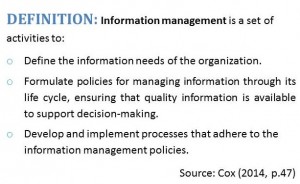Information is a resource that organizations use and like other resources, the information needs to be managed. This blog outlines 10 information management functions. Typical definitions of information management refer to information management as managing the processes that affect information through the information life cycle. Information management problems can occur at any stage in the life cycle.
Information management includes the following functions to support this set of activities.
Functions of Information Management
- Goal setting: A vision is needed to determine how information management is measured in the organization in order to determine how the resources should be used to manage information effectively. Clear goals have to be set about the utilization of the information resource. These should be practical and measurable goals derived from the information strategy that align with the needs of the organization for information.
- Forecasting: Organizations are continually changing and the demands for information change in response to changes in the internal and external environment of the organization. Part III of the book considers different changes to the organization such as changes in technology or leadership, in terms of how the changes affect information management. Resources have to be managed to meet both the current daily demands for information and the predicted information needs of the organization in the medium and long term. This requires issues such as capacity and capability to be considered to ensure that data are accurately captured, cleaned and stored to support the long term information needs of the organization.
- Planning: There are conflicting demands for information in the organization and different priorities for addressing the problems relating to the capture, use, availability, storage, security and destruction of information across the organization. Plans have to be developed to prioritize the work required to perform and improve each of the processes in the information life cycle. This requires prioritizing the often conflicting demands to address issues with the availability, quality and security of information in the organization.
- Organizing: Information management requires resources to be organized to support the plans to achieve the goals of information management in the organization. This will include arranging resources, including people, systems and information technology, to capture, store and retrieve information in order to meet the different demands for information throughout the organization and between partner organizations.
- Decision-making: Decisions have to made about the optimum approach to use and organize all resources in the organization, including information. This requires assessing the conflicting needs of different organizational functions. Trade-offs have to be agreed to ensure that information can be defined and captured to support the whole business of the organization. Priorities have to be agreed and actions taken to ensure that the goals set can be achieved.
- Co-ordinating: Information management involves the co-ordination of activities to perform the tasks in the information life cycle. This involves determining the different needs and priorities for information management in different areas of the organization and seeking to align them to maximize the potential for efficient and effective use of the information resource. For example, this may mean bringing forward data cleaning tasks to take advantage of a new information system being developed. It will also include establishing controls to enable and prevent access to information, determining who can access or change information, when and how.
- Controlling: The information resource, as other resources, needs to be controlled in order to meet the needs of the organization. Information management controls the process relating to the information life cycle to ensure that information is available when needed. It seeks to maintain information integrity and information security to provide reliable information to meet the different needs for information throughout the organization. Controls are also needed to check that the information management processes are operating effectively and that information is available to meet the different needs of the organization’s functions.
- Enabling: Information management involves putting structures in place to enable the processes to be performed to organize and control the information resource. This includes the information technology infrastructure to capture, maintain and provide secure access to the organization’s information. It also involves establishing the structures of people, processes and policies needed for the efficient and effective management of information.
- Resourcing: The activities of information management require resources to be used and invested. People, finance, technology and time are expended on managing the information resource. Decisions have to be taken about how much an organization can afford to allocate resources to managing information; these decisions have to consider the value of information to the organization and both the financial and non-financial costs arising from poor information management.
- Monitoring: Processes are needed to monitor the efficiency and effectiveness of information management in achieving its goals and to take action when necessary.
The management of information in an organization is a continuous process that needs to respond to changes in the internal and external environment of the organization. As technology changes, new opportunities arise to collect data (such as data from potential customers leaving a store without making a purchase), which pose new challenges for managing information in the organization.
Further Reading: The information life cycle is outlined in Chapter 1 and information management processes are discuss in Chapter 5.

